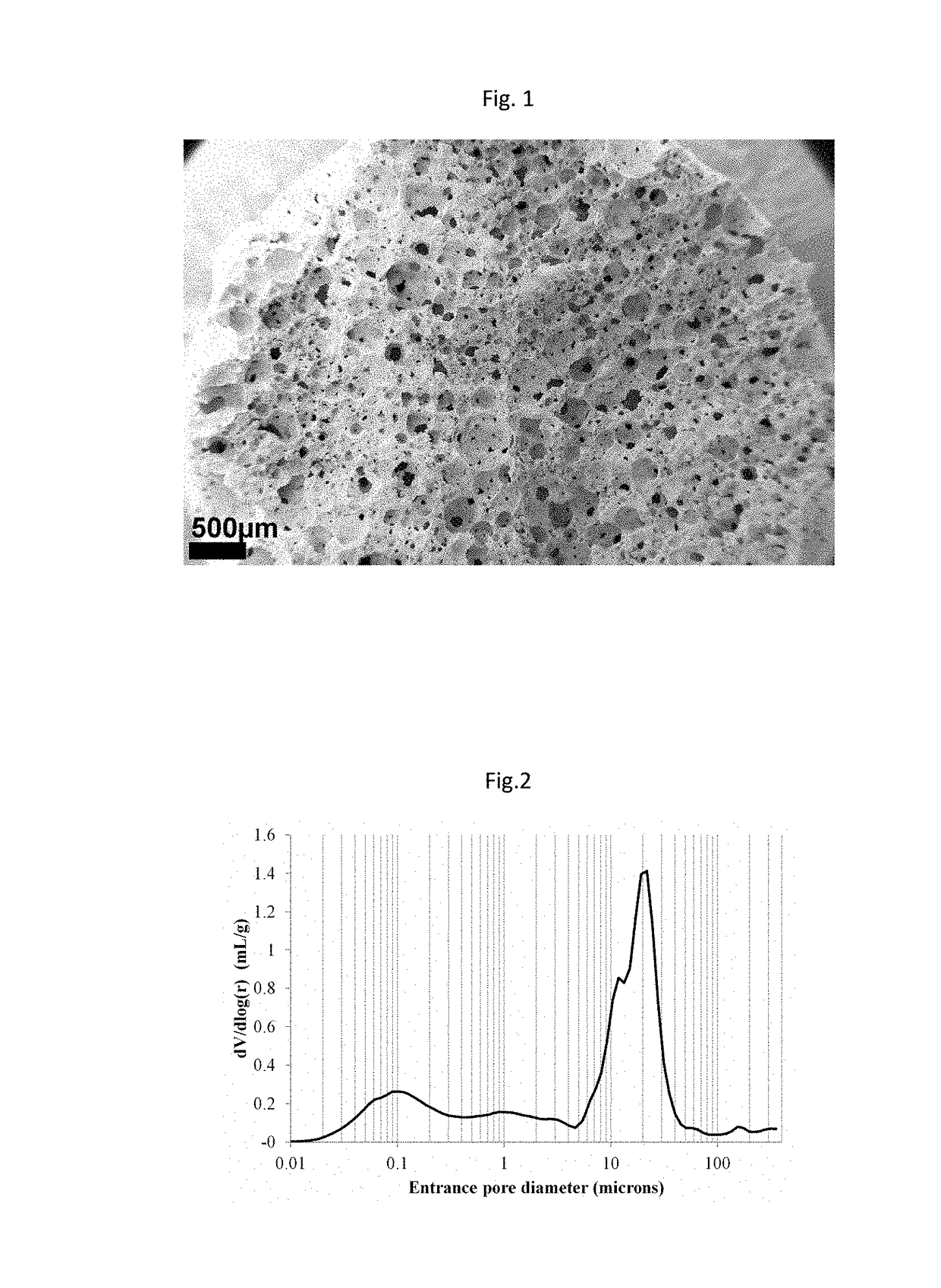New single-step manufacturing process for foamed biomaterials
a biomaterial and single-step technology, applied in the field of biomaterial preparation processes, can solve the problems of obstructing resorption and bone tissue transformation, excessively slow resorption kinetics, and slow process speed, and achieve the effect of adequate resorption ra
- Summary
- Abstract
- Description
- Claims
- Application Information
AI Technical Summary
Benefits of technology
Problems solved by technology
Method used
Image
Examples
examples 1-4
[0066]For the foam preparation, a liquid phase comprising 1 wt % of Tween80° (Polysorbate 80: polyoxyethylene (20) sorbitan monooleate or (x)-sorbitan mono-9-octadecenoate poly(oxy-1,2-ethanediyl) dissolved in distilled water was used. A powder phase comprising alpha-TCP particles including 2 wt % of precipitated hydroxyapatite as seed material was used. The liquid-to-powder ratio was chosen between 0.45 and 0.75 mL / g. The foams were prepared by simultaneously mixing and foaming the two phases, by mechanical whipping at 6000 rpm during 30 s, and were then moulded by injection into cylindrical moulds and allowed to set during approximately 24 hours, at 100% relative humidity and 37° C., followed by 6 days submerged in distilled water at 37° C. The compressive strength, mean interconnection diameter and total porosity were then evaluated for each of the foams. For all foams that were prepared, it was observed that an interconnected macroporous paste was obtained. Once submerged in dis...
examples 5-7
[0069]For the foam preparation, a liquid phase comprising 1 wt % of Tween80® dissolved in distilled water was used. A powder phase comprising alpha-TCP particles including 2 wt % of precipitated hydroxyapatite as seed material and a variable percentage of Pluronic F127 (Poloxamer 407), a polymeric surfactant based on ethylene oxide—propylene oxide block polymers was used. The liquid-to-powder ratio was fixed at 0.65 mL / g. The foam was prepared by simultaneously mixing and foaming the two phases, by mechanical whipping at 6000 rpm during 25 s and were then molded by injection into cylindrical moulds and allowed to set during approximately 24 hours at 100% relative humidity and 37° C., followed by 6 days submerged in distilled water at 37° C. The compressive strength, mean interconnection diameter and total porosity were then evaluated for each foam.
TABLE 2PluronicCompressive strengthTotal porosityMean diameter ofExample No.(weight %)(MPa ± SD)(% ± SD)interconnections (μm ± SD)300.29 ...
example 8
[0071]For the foam preparation, a liquid phase comprising 1 wt % of Pluronic F-127 (Poloxamer 407) and 8 wt % of NaH2PO4 as accelerant dissolved in distilled water was used. A powder phase comprising alpha-TCP particles including 2 wt % of precipitated hydroxyapatite as seed material and 9 wt % of Pluronic F127 (Poloxamer 407) was used. The liquid-to-powder ratio was fixed at 0.55 mL / g.
[0072]The powder phase was placed in a 3 mL syringe while the liquid phase was placed in a 5 mL syringe. The two syringes were connected tip-to-tip using a double-female luer-lock connector. 10 back-and-forth movements were performed to simulatenously mix and foam the two phases, during 15 s. The foam was then moulded by injection into cylindrical molds and allowed to set during 7 d at 100% relative humidity and 37° C.
[0073]The entrance pore size distribution as measured by mercury intrusion porosimetry is reported in FIG. 2. The total porosity evaluated by mercury intrusion porosimetry is 74.0%, 55.5...
PUM
| Property | Measurement | Unit |
|---|---|---|
| weight % | aaaaa | aaaaa |
| weight % | aaaaa | aaaaa |
| weight % | aaaaa | aaaaa |
Abstract
Description
Claims
Application Information
 Login to View More
Login to View More - R&D
- Intellectual Property
- Life Sciences
- Materials
- Tech Scout
- Unparalleled Data Quality
- Higher Quality Content
- 60% Fewer Hallucinations
Browse by: Latest US Patents, China's latest patents, Technical Efficacy Thesaurus, Application Domain, Technology Topic, Popular Technical Reports.
© 2025 PatSnap. All rights reserved.Legal|Privacy policy|Modern Slavery Act Transparency Statement|Sitemap|About US| Contact US: help@patsnap.com

